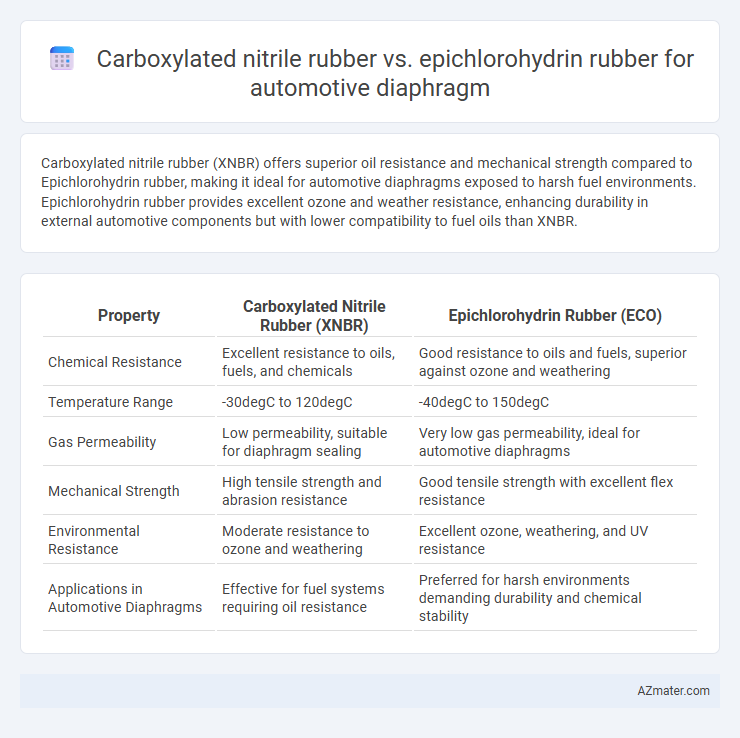Carboxylated nitrile rubber (XNBR) offers superior oil resistance and mechanical strength compared to Epichlorohydrin rubber, making it ideal for automotive diaphragms exposed to harsh fuel environments. Epichlorohydrin rubber provides excellent ozone and weather resistance, enhancing durability in external automotive components but with lower compatibility to fuel oils than XNBR.
Table of Comparison
| Property | Carboxylated Nitrile Rubber (XNBR) | Epichlorohydrin Rubber (ECO) |
|---|---|---|
| Chemical Resistance | Excellent resistance to oils, fuels, and chemicals | Good resistance to oils and fuels, superior against ozone and weathering |
| Temperature Range | -30degC to 120degC | -40degC to 150degC |
| Gas Permeability | Low permeability, suitable for diaphragm sealing | Very low gas permeability, ideal for automotive diaphragms |
| Mechanical Strength | High tensile strength and abrasion resistance | Good tensile strength with excellent flex resistance |
| Environmental Resistance | Moderate resistance to ozone and weathering | Excellent ozone, weathering, and UV resistance |
| Applications in Automotive Diaphragms | Effective for fuel systems requiring oil resistance | Preferred for harsh environments demanding durability and chemical stability |
Introduction to Automotive Diaphragms
Automotive diaphragms require materials with excellent chemical resistance, flexibility, and durability to withstand harsh operating conditions. Carboxylated nitrile rubber (XNBR) offers superior oil and fuel resistance along with enhanced mechanical strength, making it ideal for fuel system diaphragms. Epichlorohydrin rubber (ECO) excels in resistance to heat, ozone, and weathering, providing long-lasting performance in automotive air brake and transmission diaphragms.
Overview of Carboxylated Nitrile Rubber (XNBR)
Carboxylated Nitrile Rubber (XNBR) offers enhanced tensile strength, abrasion resistance, and oil resistance compared to standard nitrile rubber, making it ideal for automotive diaphragms exposed to harsh fluids and mechanical stress. Its carboxyl groups improve crosslinking density and adhesion properties, contributing to superior durability and chemical stability under extreme temperature variations. XNBR excels in sealing applications within fuel systems and brake components, outperforming Epichlorohydrin rubber by providing better hydrocarbon resistance and longer lifecycle performance.
Overview of Epichlorohydrin Rubber (ECO)
Epichlorohydrin rubber (ECO) offers superior resistance to heat, oils, and weathering, making it ideal for automotive diaphragm applications requiring durability under harsh conditions. Its low gas permeability and excellent flex fatigue performance ensure reliable sealing and extended service life compared to carboxylated nitrile rubber. Due to its balanced chemical resistance, ECO is preferred in brake systems and fuel handling components subjected to exposure from fuels, oils, and varying temperatures.
Chemical Resistance Comparison
Carboxylated nitrile rubber (XNBR) offers superior chemical resistance against oils, fuels, and solvents commonly encountered in automotive environments, ensuring enhanced durability for diaphragms. Epichlorohydrin rubber (ECO) exhibits excellent resistance to heat, ozone, and weathering but has moderate resistance to hydrocarbons and certain chemicals compared to XNBR. For automotive diaphragms exposed to aggressive fuels and lubricants, XNBR provides a more chemically robust solution, whereas ECO excels in applications requiring resistance to environmental aging.
Temperature Resistance and Performance
Carboxylated nitrile rubber (XNBR) offers superior temperature resistance up to 120degC, making it ideal for automotive diaphragms exposed to moderate heat and aggressive fluids. Epichlorohydrin rubber (CO) demonstrates excellent performance at higher temperatures reaching 150degC, with outstanding oil, fuel, and ozone resistance suitable for demanding engine environments. Choosing between XNBR and CO depends on the specific temperature and chemical exposure requirements, balancing thermal stability with chemical compatibility for optimal diaphragm durability.
Mechanical Properties and Durability
Carboxylated nitrile rubber (XNBR) offers superior tensile strength and abrasion resistance compared to epichlorohydrin rubber (ECO), making it ideal for automotive diaphragm applications requiring enhanced mechanical properties. XNBR exhibits better chemical resistance and improved low-temperature flexibility, contributing to longer service life under harsh operating conditions. Epichlorohydrin rubber, while offering excellent ozone and fuel resistance, generally shows lower tensile strength and elongation, which can limit durability in dynamic sealing environments.
Cost Analysis and Availability
Carboxylated nitrile rubber (XNBR) offers a balanced cost-performance ratio with moderate raw material prices and wide availability, making it suitable for mass-produced automotive diaphragms. Epichlorohydrin rubber (ECO), while generally more expensive due to complex synthesis and limited suppliers, provides superior resistance to fuels and oils, justifying its cost in high-performance or specialized automotive applications. Market availability challenges for ECO can lead to longer lead times and higher procurement costs compared to XNBR, impacting overall project budget and timeline.
Compatibility with Automotive Fluids
Carboxylated nitrile rubber (XNBR) exhibits superior resistance to automotive fluids such as fuels, oils, and hydraulic fluids, maintaining excellent elasticity and durability in diaphragm applications. Epichlorohydrin rubber offers good compatibility with oils and some fuels but tends to have lower swelling resistance compared to XNBR when exposed to aggressive fluids like brake fluids and glycol-based coolants. The enhanced polar groups in XNBR improve fluid resistance and chemical bonding, making it more suitable for automotive diaphragms subjected to diverse fluid environments.
Typical Applications in Automotive Diaphragms
Carboxylated nitrile rubber (XNBR) offers superior oil resistance and tensile strength, making it ideal for automotive diaphragms that withstand exposure to fuels, oils, and hydraulic fluids, such as in brake systems and fuel pumps. Epichlorohydrin rubber (ECO) provides excellent ozone and weather resistance with good fuel and oil compatibility, commonly used in transmission diaphragms and engine mounts requiring flexibility and durability under varying temperatures. Both materials ensure reliable performance in automotive diaphragms but are selected based on specific operational conditions including chemical exposure and mechanical stress.
Conclusion: Choosing the Right Rubber for Automotive Diaphragms
Carboxylated nitrile rubber (XNBR) offers superior oil resistance and mechanical strength, making it ideal for automotive diaphragms exposed to harsh fluids and dynamic stress. Epichlorohydrin rubber (CO) provides excellent resistance to ozone, weathering, and fuel permeation, suitable for applications requiring high durability in outdoor and fuel-related environments. Selecting the right rubber depends on specific operating conditions, with XNBR favored for oil and abrasion resistance, while CO excels in fuel and environmental stability.

Infographic: Carboxylated nitrile rubber vs Epichlorohydrin rubber for Automotive diaphragm
 azmater.com
azmater.com